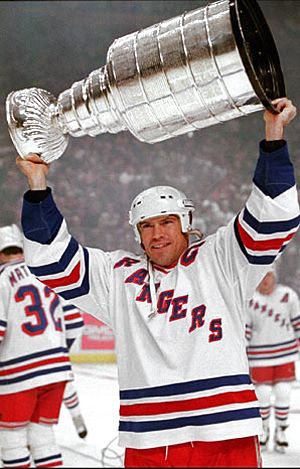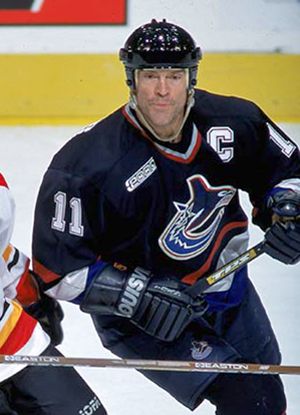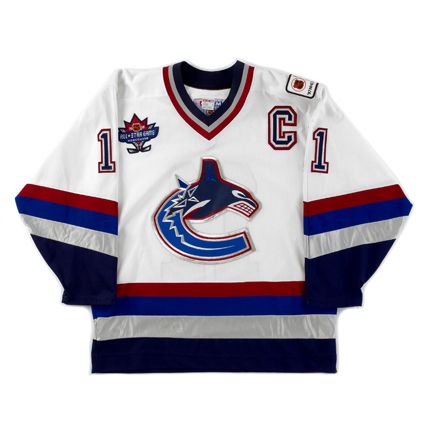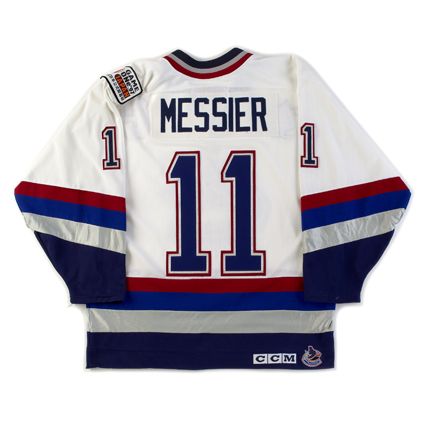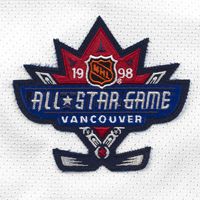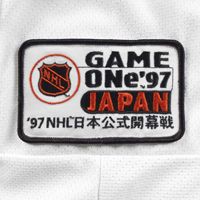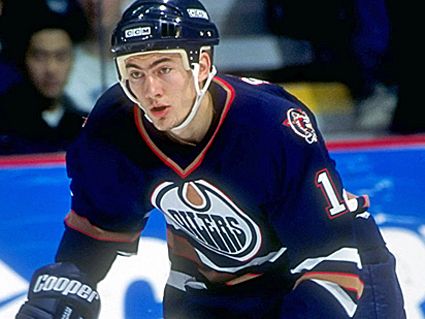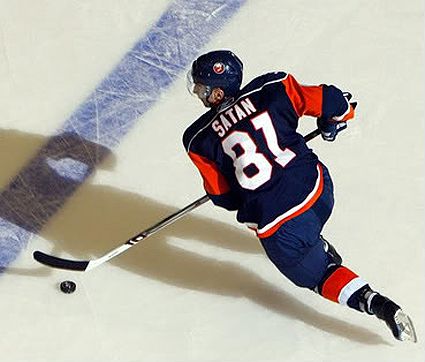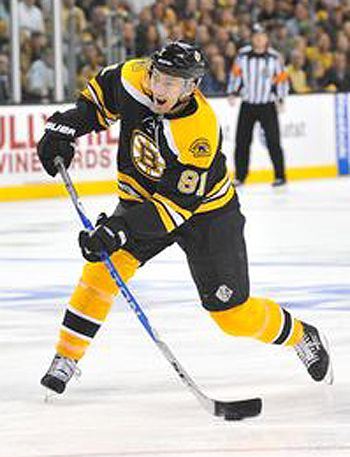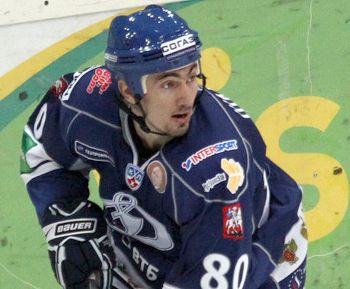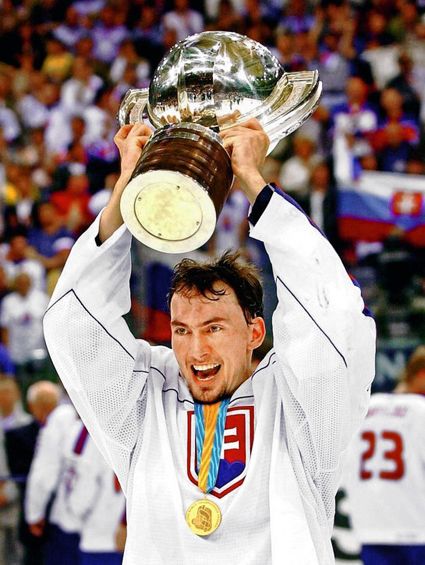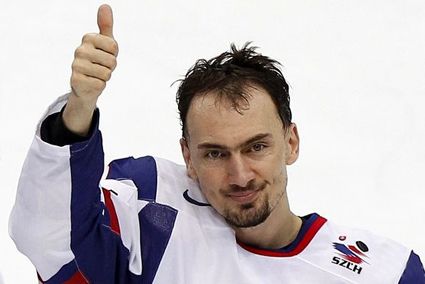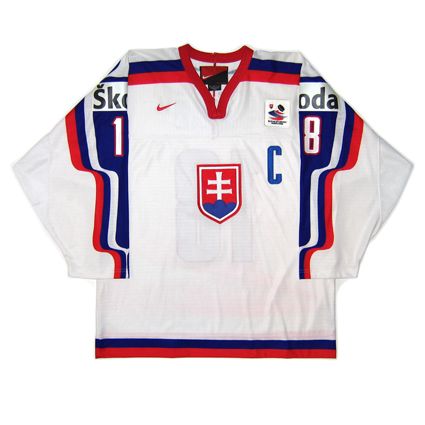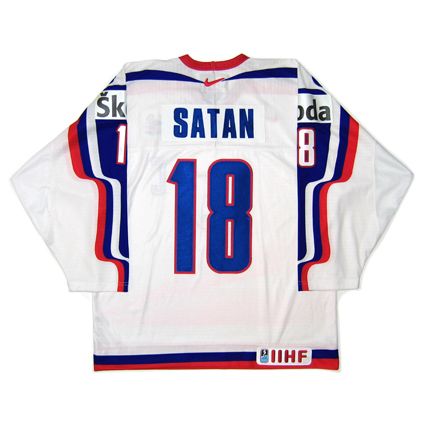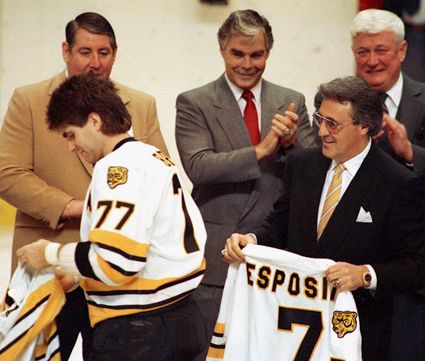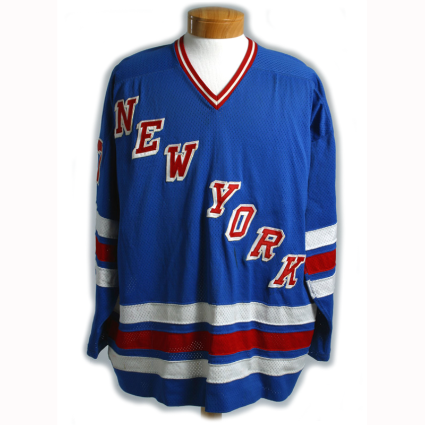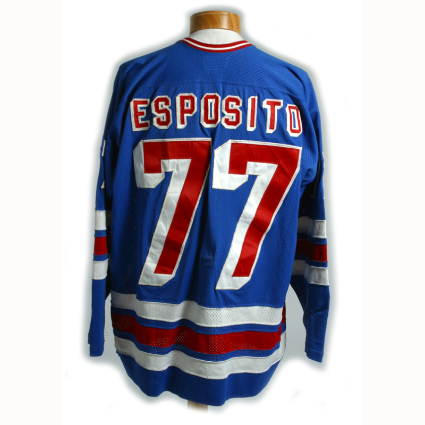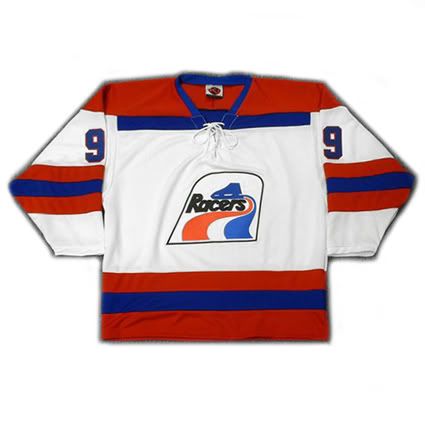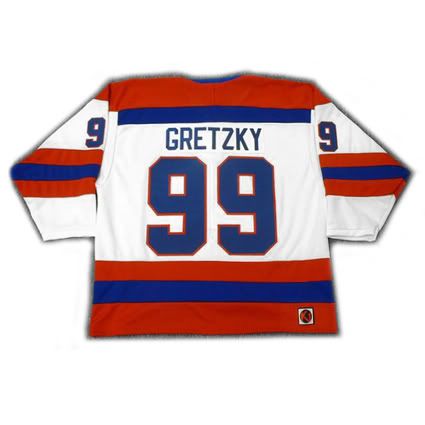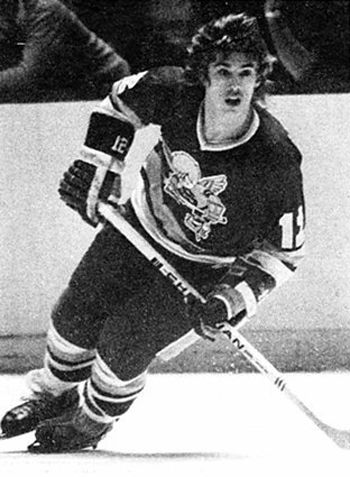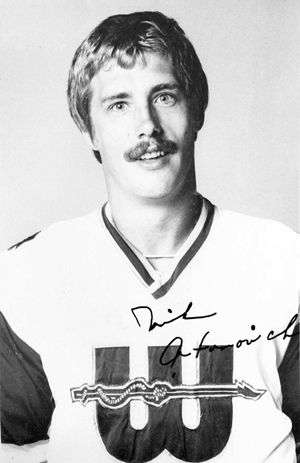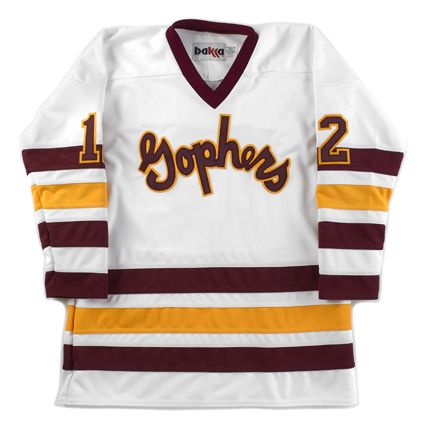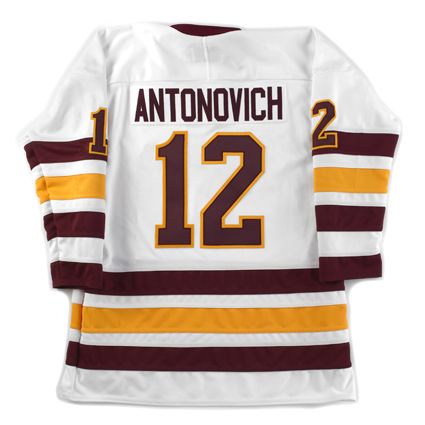Saturday, October 24, 2009
1979-80 New York Islanders Mike Bossy Jersey
Mike Bossy had a prolific junior hockey career for the Laval National, with whom he played for five seasons, beginning with 4 appearances in 1972-73. Playing a full season in 1973-74, he reeled off a 70 goal, 118 point season in 68 games.
He kept his foot on the gas the following year, topping that with an impressive 84 goals and 149 points in 67 games, 2.22 points per games. In the post season, his torrid pace continued with 38 more points in 16 games. Over the next two seasons he would add 79 goals and 136 points followed by another 75 goals and 126 points to set the all-time QMJHL record with 309 career goals, a mark which still stands today and ranks 28 goals higher that the next closest pursuer.
Thought of as being too timid by NHL scouts, Bossy was not chosen until 15th overall in the 1977 NHL Amateur Draft, having been passed over by the New York Rangers and Toronto Maple Leafs not once, but twice.
Playing on a line with Bryan Trottier and Clark Gilles, Bossy would set the hockey world on fire when he scored 53 goals in his rookie season of 1977-78, the first rookie to ever reach 50, while winning the Calder Trophy in the process.
The following season he would better that by becoming only the second player after Maurice Richard, and first in 36 years, to score 50 goals in 50 games. Bossy did it in dramatic style with two goals in the last five minutes of game number 50. He would finish the season with 69 goals to lead the league and 57 assists for 126 points, good for fourth overall.
1979-80 would see Bossy once more top the 50 mark with 51 goals in 75 games and the Islanders would capture their first of four consecutive Stanley Cup Championships as Bossy contributed 23 points in just 16 games.
While topping 50 goals the previous season, he did fail to reach 100 points during the regular season. Over the course of the next six seasons, he would blow past the 100 point level, never scoring less than 117, with a high of 147 in 1981-82.
During the 1980-81 season he would set a career high in goals with 68, which included becoming the fastest player to ever reach 250 goals on this date in 1981. His 68 goals once again lead the NHL and he added a remarkable 17 goals and 35 points in 18 playoff games as the Islanders would capture their second straight Stanley Cup.
Their third Stanley Cup Championship would see Bossy be recognized with the Conn Smythe Trophy as playoff MVP following 17 goals and 27 points in 19 games. This came on the heels of his 147 point regular season and his second consecutive 60 goal season when he tallied 64.
The Islander dynasty was now in full force and Bossy once more reached 60 goals, this time on the nose with an even 60. His 118 point regular season continued his 100 point season streak and the playoffs would again see him get his now customary 17 goals (for the third year in a row and the only player to ever do so) and 26 points in 19 games. He would also be recognized for his style of play with the first of three Lady Byng Trophies following the season.
1983-84 was another 118 point season with 51 goals scored. The Islanders would make it once more to the finals, but the dynasty would end as they were defeated by the up and coming Edmonton Oilers 4 games to 1. The Islanders 21 playoff games would see Bossy contribute 18 points. He was the recipient of his second Lady Byng Trophy after being whistled for just 8 penalty minutes for the entire season, the second lowest total of his career following just 6 during his rookie campaign.
His remarkable goal scoring consistency continued unabated, as 58 more would be added to his career total during a 117 point campaign in 1984-85. 10 more playoff games allowed Bossy to add another 11 points for the Islanders.
Showing no signs of slowing down, he would reach 61 goals, paired with 62 assists, giving him his highest point total in four seasons with 123 which included becoming just the 20th player in league history to score 1,000 career points. He would also capture this third Lady Byng Trophy in the space of four seasons as well.
Now slowed by back injuries, his final season of 1986-87, Bossy appeared in 63 games and scored 38 goals and 75 points, still over a point per game, before retiring at the age of just 30.
His final career totals of 573 goals and 553 assists for 1,126 points in 752 games would give him a final career average of 1.50 points per game over his ten NHL seasons and his 160 career playoff points in 129 games were a 1.24 points per game clip. At the time of his retirement, he held the record for most goals by a rookie and most assists and points by a right wing in a single season. He still ranks third all time in hat tricks with 39. He also reached 100 goals faster than any player in history, doing so in just 129 games. He was also the quickest at one point to 300 and 500 career goals scored.
His goals per game average of .762 in the regular season is the highest in NHL history and his playoff goals per game average of .659 is second only to Mario Lemieux.
He also still holds the NHL record for the most consecutive 50 goal seasons with nine, and shares the record with Wayne Gretzky for the most 60 goal seasons with five, despite playing 10 years less than Gretzky.
Internationally, he was a member of Team Canada in the 1981 and 1984 Canada Cup tournaments, earning a gold medal in in 1984. Due to the Islanders consistent playoff history, he was never available for World Championships duty.
He was inducted into the Hockey Hall of Fame in 1991 and his jersey #22 was retired by the Islanders in 1992.
Today's featured jersey is a 1985-86 New York Islanders Mike Bossy jersey as worn during the season he scored his 1,000th point.
Here is a career retrospective of Mike Bossy, which includes his dramatic 50th goal in his 50th game in 1980.
Up next is a nice interview with Bossy as he looks back on his career and a variety of topics.
A recap of the 1980 Stanley Cup Finals is next up, showing the 1980 Lake Placid Olympics patch on the Islanders jerseys. The passion and excitement of the Islander and their fans is infectious and recommended viewing. A reminder of what it's all about.
We don't know about you, but all this writing has left us hungry. Ça, c'est du bon poulet!
Labels:
Bossy Mike,
New York Islanders
Friday, October 23, 2009
1997-98 Vancouver Canucks Mark Messier Jersey
It was on this date in 1998 that Mark Messier, new to the Vancouver Canucks, scored his 600th NHL goal in a 5-0 win over the Florida Panthers, becoming a member of an exclusive club, as he was only the eighth player to ever reach 600 goals.
Messier had just joined the Canucks after six seasons in Manhattan with the New York Rangers, having famously won the Stanley Cup in 1994 to go along with the five he won as an Edmonton Oiler.
Messier, the only player to have captained two teams to the Stanley Cup, signed a three-year contract worth up to $20 million and was brought in with the intent that he would lead the Canucks to their first championship.
"Hopefully I can come in here and help out in any way that I can to bring Canada, bring Vancouver, what they're really hoping for - the Stanley Cup," Messier said when he was introduced as a Canuck. "I can't wait to get started."
It was a tall order for the first season, as the Canucks had failed to qualify for the playoffs the year before with a sub .500 record of 35-40-7 and were not selling out games either.
Vancouver beat the Rangers, Washington Capitals and Detroit Red Wings for Messier's services. It broke up the reunited Messier/Wayne Gretzky pairing that lasted only one season in New York.
Messier was made captain of the Canucks before ever playing in a game in Vancouver. His return to New York was an emotional event, as the Rangers played a tribute video to Messier on the scoreboard, which caused many, including the always emotional Messier, to shed tears. He would go on to score a goal for Vancouver later in the game, drawing applause from the fans in New York.
His final point total his first season in Vancouver was a lackluster 60 points in all 82 games. The next two seasons were curtailed by injuries, limiting him to 59 and 66 games with his point totals of just 48 and 54 suffering as a result.
The Canucks would finish the 1997-98 season with a 25-43-14 record for 64 points in the standings, worse than the previous season's 77, for last in the seven team Pacific Division as well as the Western Conference, despite the addition of Messier (60 points) and the presence of Pavel Bure (90 pts.), Alexander Mogilny (45 pts.) and Markus Naslund (34 pts.) and a rotation of goaltenders that consisted of Arturs Irbe, Garth Snow, Sean Burke and Kirk McLean. The season included losing streaks of both ten and seven games and no more than three consecutive wins. The highlight of the Canucks season would have to be hosting the 1998 NHL All-Star Game in January.
1998-99 would turn out worse for Vancouver. Their record of 23-47-12 would net them just 58 points this time, once more last, this time in the four team Northwest Division and next to last league wide. Coach Mike Keenan was fired midway through the season and replaced with Marc Crawford and high scoring superstar Pavel Bure was holding out and eventually traded to Florida for Ed Jovanovski. The Canucks were able to make a trade for an additional high draft pick to go along with their original high pick as a result of their poor finish and draft both Daniel and Henrik Sedin with their second and third overall choices.
The following season of 1999-00 would see the Canucks in a fight for a playoff spot all season long, but fall short once again, being eliminated in the second to last game, denying Messier the opportunity to play in even a single playoff game as a Vancouver Canuck, the entire reason he was brought to Vancouver in the first place. Their record of 30-29-15 for 83 points was tenth in the conference, four back of a playoff spot.
At the conclusion of his third season in Vancouver, Messier was once again a free agent and chose to return to New York and the Rangers. While in Vancouver he would average just 69 games, 12 goals, 37 assists and 54 points a season. The 162 points he would score in three years as a Canuck were only 33 more than he scored in 1989-90 in Edmonton alone.
Today's featured jersey is a 1997-98 Vancouver Canucks Mark Messier home jersey as worn during his first ever game as a Canuck. This jersey features not only the 1998 NHL All-Star Game patch, but the addition of the Game ONe '97 patch worn by the Canucks and Mighty Ducks of Anaheim when they opened the season in Toyko, Japan in advance of the first NHL participation in the Olympics, which was to be held five months later in Nagano, Japan.
The Canucks would prevail in the game 3-2 in front of a sold out crowed of 10,500. Messier would score a power play goal at 11:42 of the second period on a tap-in from from Naslund to give Vancouver a 2-1 lead at the time. He would miss the third period with a leg injury after a collision late in the second.
Here is Messier scoring a goal while wearing today's featured jersey with the 1998 All-Star Game patch on a nice feed from Pavel Bure against his former club the New York Rangers.
Here is a hungry Messier in a Canucks-like uniform making a pest out of himself with the neighbors. Yea right, hair dryer...
Messier again extolling the virtues of the snack foods. He's actually quite comfortable in front of the camera, isn't he?
That wraps up today's video segment. As you might guess, actual game footage of Messier in a Canucks uniform is quite scarce on youtube.
Dasherboard: Be sure to check out the Don Cherry tribute jerseys worn by the Kingston Frontenacs on Wednesday posted on Icethetics. They immediately join the Milwaukee Admirals Bob Ucker tribute jerseys as some of the most outlandish jerseys worn anywhere, ever.
Labels:
Messier Mark,
Vancouver Canucks
Thursday, October 22, 2009
2005 Slovakia National Team Miroslav Satan Jersey
Born on this date in 1974, Miroslav Šatan was drafted by the Edmonton Oilers 11th overall in round five of the 1993 NHL Entry Draft after playing professionally for Dukla Trencin in the final season of the Czechoslovak First Ice Hockey League of 1992-93 and then again in 1993-94 in the first season of the new Slovak Extraliga following the division of Czechoslovakia into the Czech Republic and Slovakia. Satan was a standout that season, scoring 32 goals and 48 points in just 30 games, no doubt pleasing the Edmonton Oilers who had drafted him the previous spring.
He played one well-travelled season in the minors in North America in 1994-95 with the Cape Breton Oilers of the AHL (25 games), the Detroit Vipers (8 games) and the San Diego Gulls of the IHL (6 games) and even one game with the Detroit Falcons of the low level Colonial Hockey League.
He made his NHL debut with the Oilers in 1995-96 and scored 35 goals over the course of two seasons before being traded to the Buffalo Sabres near the end of the second season in Edmonton.
He would go on to play eight seasons with the Sabres, leading them in scoring six times with a career best 40 goals in 1998-99 and a career high 75 points in 2002-03. The Sabres would also make it to the Stanley Cup Finals in 1999 for the first time in Satan's career.
Following the NHL lockout of 2004-05, when he played 18 games back in Slovakia for Slovan Bratislava, he became a free agent and chose to sign with the New York Islanders where he would finish tied for first, second and then third in team scoring during his three seasons on Long Island, highlighted by his 35 goal 66 point season in 2005-06.
Satan would then sign with the Pittsburgh Penguins for the 2008-09 season, scoring 36 points in 65 games before being placed on waivers on the trading deadline late in the season. After being assigned to the minors with the Wilkes-Barre/Scranton Penguins of the AHL, he was recalled by the Penguins a month later and rejoined the Penguins during the Stanley Cup Playoffs. He would appear in nine games and score a goal and four assists on his way to winning the Stanley Cup for the only time in his career.
His final NHL season saw Satan sign with the Boston Bruins in early January halfway through the 2009-10 season. During that season's playoffs, Satan would score the game winning goal against his old club Buffalo in double overtime and then score the series clinching goal five days later.
After 14 NHL seasons, Satan would move back to Europe to continue his career. A shortened 2010-11 season saw him play 10 games with Slovan Bratislava and 6 more with Dynamo Moscow of the KHL.
Satan would play a full season with Slovan Bratislava in 2011-12, a successful campaign that saw him average more than a point per game with 52 points in 49 games, capped off by leading all scorers with 22 points in 12 playoff games as Slovan captured the league championship.
He would play two additional seasons with Bratislava, who had now moved to the KHL for the 2012-13 season before retiring at the age of 39 following the 2-13-14 season.
Satan's final NHL totals were 1,050 games played with 363 goals and 735 points with an additional 114 goals coming while playing in Europe.
Internationally, Satan has appeared for Slovakia in the World Championships 14 times, including helping the newly formed nation climb the international ladder system in the quickest time possible, as Slovakia was initially placed in the lower levels of the system while the Czech Republic remained at the top in Pool A after Czechoslovakia divided in two.
In his first World Championships, Slovakia won Pool C in 1994 (where Satan was named Best Forward), followed immediately by Slovakia winning the Pool B in 1995 to reach the Top Division in just two years. Satan was on the Slovak roster in 1996, their first in the Top Division.
He then earned a silver medal as team captain in 2000 (where he was again named Best Forward) and was captain again as Slovakia reached the pinnacle of winning World Championship gold in 2002.
Satan was captain once more in 2003, winning bronze and appeared in the World Championships again in 2004, 2005, 2007, 2010, 2011, 2012 (winning silver), 2013 and one final time in 2014.
Additionally, he has played in the World Juniors in 1994, the World Cup of Hockey in 1996 and 2004, again as team captain, as well as the 1994, 2006 and 2010 Winter Olympics. He was also named to the 2002 team, but with the NHL not suspending play during the qualification rounds, Slovakia was eliminated before he was able to participate.
In all, Satan would win one gold, two silver and a bronze at the World Championships while appearing in 180 games, scoring 86 goals while being a vital member of the of both the fledgling national team program which started life in the bottom rung "C" Pool and eventual world champions in the span of eight short years.
Today's featured jersey is a 2005 Slovakia National Team Miroslav Satan jersey. For the 2005 World Championships in Austria, all the participating team's jerseys were redesigned, only to be quickly replaced by the new Nike Swift jerseys for the 2006 Olympics, leaving today's featured jersey with a all-too-brief lifespan of one year, making it quite rare.
This jersey features the IIHF patch, the Slovakia Ice Hockey Federation patch, Satan's captain's "C" and a pair of our custom made Skoda sponsorship patches, from the loyal sponsor of the IIHF World Championships.
Here is a compilation of goals scored by Satan. Do not miss the first one, shot between his legs and behind his back. A real beauty.
Last up is a highly professional look at Satan's national team career well worth your time.
He played one well-travelled season in the minors in North America in 1994-95 with the Cape Breton Oilers of the AHL (25 games), the Detroit Vipers (8 games) and the San Diego Gulls of the IHL (6 games) and even one game with the Detroit Falcons of the low level Colonial Hockey League.
He made his NHL debut with the Oilers in 1995-96 and scored 35 goals over the course of two seasons before being traded to the Buffalo Sabres near the end of the second season in Edmonton.
Satan broke into the NHL with the Oilers
He would go on to play eight seasons with the Sabres, leading them in scoring six times with a career best 40 goals in 1998-99 and a career high 75 points in 2002-03. The Sabres would also make it to the Stanley Cup Finals in 1999 for the first time in Satan's career.
Satan played eight seasons with Buffalo
Following the NHL lockout of 2004-05, when he played 18 games back in Slovakia for Slovan Bratislava, he became a free agent and chose to sign with the New York Islanders where he would finish tied for first, second and then third in team scoring during his three seasons on Long Island, highlighted by his 35 goal 66 point season in 2005-06.
Satan scored a high of 35 goals on Long Island
Satan would then sign with the Pittsburgh Penguins for the 2008-09 season, scoring 36 points in 65 games before being placed on waivers on the trading deadline late in the season. After being assigned to the minors with the Wilkes-Barre/Scranton Penguins of the AHL, he was recalled by the Penguins a month later and rejoined the Penguins during the Stanley Cup Playoffs. He would appear in nine games and score a goal and four assists on his way to winning the Stanley Cup for the only time in his career.
Satan celebrates the only Stanley Cup of his career in 2009
His final NHL season saw Satan sign with the Boston Bruins in early January halfway through the 2009-10 season. During that season's playoffs, Satan would score the game winning goal against his old club Buffalo in double overtime and then score the series clinching goal five days later.
Satan spent half a season with Boston
After 14 NHL seasons, Satan would move back to Europe to continue his career. A shortened 2010-11 season saw him play 10 games with Slovan Bratislava and 6 more with Dynamo Moscow of the KHL.
A rare shot of Satan with Dynamo Moscow
Satan would play a full season with Slovan Bratislava in 2011-12, a successful campaign that saw him average more than a point per game with 52 points in 49 games, capped off by leading all scorers with 22 points in 12 playoff games as Slovan captured the league championship.
He would play two additional seasons with Bratislava, who had now moved to the KHL for the 2012-13 season before retiring at the age of 39 following the 2-13-14 season.
Satan as captain of Bratislava in the KHL
Satan's final NHL totals were 1,050 games played with 363 goals and 735 points with an additional 114 goals coming while playing in Europe.
Internationally, Satan has appeared for Slovakia in the World Championships 14 times, including helping the newly formed nation climb the international ladder system in the quickest time possible, as Slovakia was initially placed in the lower levels of the system while the Czech Republic remained at the top in Pool A after Czechoslovakia divided in two.
In his first World Championships, Slovakia won Pool C in 1994 (where Satan was named Best Forward), followed immediately by Slovakia winning the Pool B in 1995 to reach the Top Division in just two years. Satan was on the Slovak roster in 1996, their first in the Top Division.
He then earned a silver medal as team captain in 2000 (where he was again named Best Forward) and was captain again as Slovakia reached the pinnacle of winning World Championship gold in 2002.
Satan hoisting the World Championship trophy
Satan was captain once more in 2003, winning bronze and appeared in the World Championships again in 2004, 2005, 2007, 2010, 2011, 2012 (winning silver), 2013 and one final time in 2014.
Additionally, he has played in the World Juniors in 1994, the World Cup of Hockey in 1996 and 2004, again as team captain, as well as the 1994, 2006 and 2010 Winter Olympics. He was also named to the 2002 team, but with the NHL not suspending play during the qualification rounds, Slovakia was eliminated before he was able to participate.
In all, Satan would win one gold, two silver and a bronze at the World Championships while appearing in 180 games, scoring 86 goals while being a vital member of the of both the fledgling national team program which started life in the bottom rung "C" Pool and eventual world champions in the span of eight short years.
Today's featured jersey is a 2005 Slovakia National Team Miroslav Satan jersey. For the 2005 World Championships in Austria, all the participating team's jerseys were redesigned, only to be quickly replaced by the new Nike Swift jerseys for the 2006 Olympics, leaving today's featured jersey with a all-too-brief lifespan of one year, making it quite rare.
This jersey features the IIHF patch, the Slovakia Ice Hockey Federation patch, Satan's captain's "C" and a pair of our custom made Skoda sponsorship patches, from the loyal sponsor of the IIHF World Championships.
Today's first featured videos are from the 2002 World Championships when the Slovakian National Team excited the nation by capturing the gold medal.
Here is a compilation of goals scored by Satan. Do not miss the first one, shot between his legs and behind his back. A real beauty.
Last up is a highly professional look at Satan's national team career well worth your time.
Labels:
Satan Miroslav,
Slovakia
Wednesday, October 21, 2009
1979-80 New York Rangers Phil Esposito Jersey
On this date in 1979, Phil Esposito, then with the New York Rangers, scored a power play goal against the Pittsburgh Penguins for his 1500th NHL point, only the second player in NHL history after Gordie Howe to do so.
After eight and a half seasons in Boston, which included winning the Stanley Cup twice, winning the Art Ross Trophy as the league's leading scorer five times and the Hart Trophy as league MVP twice, Esposito was traded to the Rangers along with Carol Vadnais for Brad Park, Joe Zanussi and Jean Ratelle.
Excerpted from Phil Esposito's book "Thunder and Lightning" (available used on Amazon.com in hardcover for less than a dollar!)
On arrival in New York, Esposito found his familiar #7 taken by 16 year Rangers veteran Rod Gilbert and chose to simply double his customary #7 to the unusually high sweater number for the time of #77.
His first season of adjustment in New York would see Esposito play in 62 games and score 29 goals and 38 assists for 67 points to go along with his 16 points in the first 12 games of the season he played in Boston. While not able to reach the lofty league-leading point totals of 125-150 points as he had done with Boston, while being the first player to ever score 100 points in a season, Esposito still averaged 35 goals a season while in New York and 80 points over the final five full seasons of his career and led the Rangers in scoring three times.
On November 4, 1977 Esposito would score his 600th NHL goal versus the Vancouver Canucks, becoming the first Ranger to reach that milestone and would then go onto to notch his 1500th point early in the 1979 season against the Pittsburgh Penguins.
When he retired in 1981, he was second to Howe in all-time league scoring with 1282 games played, 717 goals and 873 assists for 1590 points for an average of 1.24 points per game over 18 NHL seasons.
Esposito was elected to the Hockey Hall of Fame in 1984 and had his original #7 famously retired by the Boston Bruins in 1987 when Ray Bourque, the current wearer of #7 for Boston, pulled of his jersey to reveal a permanent change to #77 in Phil's honor.
Today's featured jersey is a game worn 1979-80 New York Rangers Phil Esposito jersey. This jersey was auctioned off by Leland's in December of 2004 and sold for a high bid of $8,559.34, with the final sale price with fees added on topping $10,000.
This style Rangers jersey was first introduced in 1978 after the Rangers brief switch to a much more modern look worn for two seasons in 1976-77 and 1977-78. It was also the first Rangers jersey to ever have "New York" diagonally across the front in the history of the franchise. This style lasted nine seasons before the club permanently reverted back to having "Rangers" diagonally across the front of their road jerseys once more in time for the 1987-88 season.
First up todays is the "Legends of Hockey" biography on Phil Esposito.
Next up is the jersey retirement ceremony when the Bruins retired Esposito's #7 and Ray Bourque famously shocks Phil and the stadium by giving up his number #7 to Esposito.
Here is Esposito, along with Ron Dugay, Dave Maloney and Anders Hedberg in a moment we suspect they'd all like to forget ever happened.
Unfortunately, it gets worse, as Esposito, Maloney, Hedberg and Ron Greschner take part in a sequel of even more embarrassing proportions.
We're not really sure what's happening here since this post was originally intended to be a tribute to the greatness of Phil Esposito's scoring abilities, but here's another skeleton from Phil's closet we just cannot keep to ourselves. His cohorts are Gil Gerard, Alan Thicke and The Unknown Comic. Why Phil is wearing a #14 jersey, we have no idea...
Dasherboard: Tonight is the debut of the new Minnesota Wild third jersey against the red hot Colorado Avalanche. The script crest on the front of the jersey borrows elements from the old Minneapolis Millers and St. Paul Saints minor league teams of the past and adds in the shooting star from the current Wild primary logo to tie the old and new together. The jerseys will also be worn on Saturday versus the Carolina Hurricanes.
Esposito scored his 1,600th point as a Ranger
After eight and a half seasons in Boston, which included winning the Stanley Cup twice, winning the Art Ross Trophy as the league's leading scorer five times and the Hart Trophy as league MVP twice, Esposito was traded to the Rangers along with Carol Vadnais for Brad Park, Joe Zanussi and Jean Ratelle.
Excerpted from Phil Esposito's book "Thunder and Lightning" (available used on Amazon.com in hardcover for less than a dollar!)
I was traded to the New York Rangers on November 7, 1975, in my mind a day that lives in infamy.
[Phil has just been offered a million dollar signing bonus and six-year contract at four hundred thousand dollars per season to join the Vancouver Blazers of the WHA]
[Bruins General Manager] Harry [Sinden] and I had been talking contract and he hadn't offered me very much. I went back to see him. I didn't have an agent. I never brought up he Vancouver offer. I didn't want to use that. I just told him "I don't want to leave Boston. Come on, let's have something here." He offered me a six-year deal at four hundred thousand dollars a year. I felt it was fair, considering what I had done.
"You want a no-trade clause, Phil?" he asked me.
"Harry," I said, "you and I have been through so much together, I don't need a no-trade clause. If you tell me you're not going to trade me, that's good enough for me.
As we shook hands he said, "Phil, you will be here as long as I'm here."
That was in October, just before the 1975-76 season began on the fourth, and I was happier than a pig in [slop].
We were on the road, and I was playing well even though I didn't particularly like Don Cherry's coaching style.
[At this point Esposito runs into Jim Pattinson who tells him he should have taken his offer to join the Blazers because Boston is going to trade him]
The next morning the phone rang, and [my roomate] Hank picked it up. Hank said, "Phil, it's Grapes." "Grapes" was out nickname for Don Cherry. I wondered, it's seven-thirty in the morning. We don't play until tomorrow. Why is he waking me up?
Hank handed me the phone.
Cherry said, "I've got to talk to you." I thought to myself, Oh, Jesus. I said, "If you want to talk to me, you're going to have to come up and see me." I hung up on him.
Hank said, "What's up?"
I said, "I think I've been traded."
There was a knock on the door, and in came Don Cherry and Bobby Orr. Don was wearing the ugliest pajamas I ever saw in my life. Don made a lot of money in Canada by wearing really ugly clothes. Bobby Orr was in a T-shirt and a pair of slacks.
I was sitting at the end of my bed in my underwear, hungover, and I had my head in my hands.
"What the [frick] is going on, Grapes?"
He said, "Phil, I ... well, I ..."
"Come on. Tell me. I've been traded, haven't I?"
He said, "Yeah."
[Frick] me," I said. "For who? And where?" He looked at me, and looked at Bobby, who was standing by the window. I said, "If you tell me New York, I'm going to jump out that window."
The New York Rangers were our arch-rivals. I hated New York. Whenever we went to play at Madison Square Garden, all we got to see was the dingy block between 7th and 8th Avenues and 33rd and 34th Streets. We never saw the hot spots. We would fly in on Eastern Airlines the day of the game, play, stay in the Statler Hilton, a rundown hotel right across the street, and fly out the next day. New York was filthy. It was the last place I wanted to go.
"Bobby, open the window," Grapes said.
That's how I learned I was going to New York.
On arrival in New York, Esposito found his familiar #7 taken by 16 year Rangers veteran Rod Gilbert and chose to simply double his customary #7 to the unusually high sweater number for the time of #77.
His first season of adjustment in New York would see Esposito play in 62 games and score 29 goals and 38 assists for 67 points to go along with his 16 points in the first 12 games of the season he played in Boston. While not able to reach the lofty league-leading point totals of 125-150 points as he had done with Boston, while being the first player to ever score 100 points in a season, Esposito still averaged 35 goals a season while in New York and 80 points over the final five full seasons of his career and led the Rangers in scoring three times.
On November 4, 1977 Esposito would score his 600th NHL goal versus the Vancouver Canucks, becoming the first Ranger to reach that milestone and would then go onto to notch his 1500th point early in the 1979 season against the Pittsburgh Penguins.
When he retired in 1981, he was second to Howe in all-time league scoring with 1282 games played, 717 goals and 873 assists for 1590 points for an average of 1.24 points per game over 18 NHL seasons.
Esposito was elected to the Hockey Hall of Fame in 1984 and had his original #7 famously retired by the Boston Bruins in 1987 when Ray Bourque, the current wearer of #7 for Boston, pulled of his jersey to reveal a permanent change to #77 in Phil's honor.
Ray Bourque surrenders his #7 to Phil Esposito
Today's featured jersey is a game worn 1979-80 New York Rangers Phil Esposito jersey. This jersey was auctioned off by Leland's in December of 2004 and sold for a high bid of $8,559.34, with the final sale price with fees added on topping $10,000.
This style Rangers jersey was first introduced in 1978 after the Rangers brief switch to a much more modern look worn for two seasons in 1976-77 and 1977-78. It was also the first Rangers jersey to ever have "New York" diagonally across the front in the history of the franchise. This style lasted nine seasons before the club permanently reverted back to having "Rangers" diagonally across the front of their road jerseys once more in time for the 1987-88 season.
First up todays is the "Legends of Hockey" biography on Phil Esposito.
Next up is the jersey retirement ceremony when the Bruins retired Esposito's #7 and Ray Bourque famously shocks Phil and the stadium by giving up his number #7 to Esposito.
Here is Esposito, along with Ron Dugay, Dave Maloney and Anders Hedberg in a moment we suspect they'd all like to forget ever happened.
Unfortunately, it gets worse, as Esposito, Maloney, Hedberg and Ron Greschner take part in a sequel of even more embarrassing proportions.
We're not really sure what's happening here since this post was originally intended to be a tribute to the greatness of Phil Esposito's scoring abilities, but here's another skeleton from Phil's closet we just cannot keep to ourselves. His cohorts are Gil Gerard, Alan Thicke and The Unknown Comic. Why Phil is wearing a #14 jersey, we have no idea...
Labels:
Esposito Phil,
New York Rangers
Tuesday, October 20, 2009
1978-79 Indianapolis Racers Wayne Gretzky Jersey
Back in 1978 the NHL was embroiled in a feud with the World Hockey Association, which included fierce competition for signing players. The WHA had already lured away many established NHL stars, such as Bobby Hull and Gerry Cheevers, with offers of big money deals. Even Gordie Howe was lured out of retirement for a chance to play with his sons Mark and Marty.
The next tactic that the WHA employed was to look to Europe for players, which led to Swedes Anders Hedberg and Ulf Nilsson joining the Winnipeg Jets and Vaclav Nedomansky defecting from Czechoslovakia and playing for the Toronto Toros.
The third area the WHA would exploit to the fullest was flaunting the NHL rule which did not allow the signing of players under the age of 20. The Birmingham Bulls owner John Bassett signed as many young and talented players as he could, such as Rick Vaive, Michel Goulet, Rob Ramage, Craig Hartsburg, Gaston Gingras, Pat Riggin and Keith Crowder. It was a very good year to have been born in 1959, as all of the "Baby Bulls" were, except Goulet, who was the youngest of the lot, born in 1960, making him just 18 at the time.
Despite all the signings by the Bulls, the star prize in the race to sign underage players went to Nelson Skalbania, who snared a seventeen-year-old Wayne Gretzky for his Indianapolis Racers franchise. Gretzky wanted to play in the NHL, but was stymied by the 20 year old minimum age limit and did not think that another three years in junior hockey were necessary.
Other youngsters snapped up by the WHA included future stars Ken Linseman, Mike Gartner and Mark Messier, who also had a cup of coffee with the Racers (5 games and no points) before joining the Cincinnati Stingers and again showing little signs of the success that would follow when he scored but one goal and ten assists in 47 games.
It was on this date that Gretzky would score his first two goals as a professional, and two out of the three he would score in just the eight games he would play as a Racer. The first goal came against Dave Dryden of the Edmonton Oilers and would be followed by the second of his career - just moments later.
Today's featured jersey is a 1978-79 Indianapolis Racers Wayne Gretzky jersey. K1 makes some rare and unusual jerseys that are nice teams to be able to obtain, such as their many WHA jerseys, however, they do have the annoying habit of making their jerseys "to be worn with pads", meaning they consistently run a size larger than just about every other manufacturer under the sun and a family of four could comfortably live in the large, billowy arms of their jerseys. We generally make a habit of taking any K1 jersey our local tailor shop and have the width of the arms reduced to a more human proportion.
We at Third String Goalie prefer a size large in CCM, Starter or ProPlayer and can live with an extra large quite well, but when it comes to K1 jerseys, a medium is our first choice. A large is passable if the extra yard of material is removed from the arms, but an extra large is more suited for use as a circus tent.
In a frankly shocking and unexpected discover today, we found video of Wayne Gretzky scoring his first two goals as a professional for the Indianapolis Racers. It was a rare occurrence for any WHA games to be shown on TV in the Minneapolis/St. Paul area during our youth, and no one had a VCR in their home at the time, so to find video of a Racers game that has been posted on youtube was certainly a welcome and surprising treat.
I'm not sure how much hype there would have been for Gretzky to have joined the Racers in Indianapolis in 1978, but we were also frankly shocked at the size of the crowd at the game and their thunderous enthusiasm.
Here is another video, profiling Gretzky's career during his transition from junior hockey to the WHA with the Racers and his quick move to the Edmonton Oilers.
Today's featured jersey is a 1978-79 Indianapolis Racers Wayne Gretzky jersey. K1 makes some rare and unusual jerseys that are nice teams to be able to obtain, such as their many WHA jerseys, however, they do have the annoying habit of making their jerseys "to be worn with pads", meaning they consistently run a size larger than just about every other manufacturer under the sun and a family of four could comfortably live in the large, billowy arms of their jerseys. We generally make a habit of taking any K1 jersey our local tailor shop and have the width of the arms reduced to a more human proportion.
We at Third String Goalie prefer a size large in CCM, Starter or ProPlayer and can live with an extra large quite well, but when it comes to K1 jerseys, a medium is our first choice. A large is passable if the extra yard of material is removed from the arms, but an extra large is more suited for use as a circus tent.
In a frankly shocking and unexpected discover today, we found video of Wayne Gretzky scoring his first two goals as a professional for the Indianapolis Racers. It was a rare occurrence for any WHA games to be shown on TV in the Minneapolis/St. Paul area during our youth, and no one had a VCR in their home at the time, so to find video of a Racers game that has been posted on youtube was certainly a welcome and surprising treat.
I'm not sure how much hype there would have been for Gretzky to have joined the Racers in Indianapolis in 1978, but we were also frankly shocked at the size of the crowd at the game and their thunderous enthusiasm.
Here is another video, profiling Gretzky's career during his transition from junior hockey to the WHA with the Racers and his quick move to the Edmonton Oilers.
Labels:
Gretzky Wayne,
Indianapolis Racers,
WHA
Monday, October 19, 2009
1996-97 Quebec Nordiques Peter Stastny Jersey
It was on this date in 1989 that Peter Statsny scored his 1000th NHL point with a goal against the Chicago Blackhawks in what would turn out to be his final season in Quebec.
Stastny joined the Nordiques, along with his brother Anton, after defecting from his native Czechoslovakia. They were joined the following year by their brother Marian, Making them the third trio of brothers to play on the same NHL team, following the Bentley brothers, Doug, Max and Reg, of the 1940's Blackhawks and the Plager brothers of the 1970's St. Louis Blues.
Peter would become the first rookie to ever score over 100 points in his first season when he netted 39 goals and accumulated 70 assists, also a rookie record, for 109 points in 1980-81, all while adapting to life in the West, including living in French-speaking Canada. He would be awarded the Calder Trophy for his efforts.
Stastny would extend his streak of 100 or more points to six consecutive seasons, one of only seven players to ever do so, averaging 119 points during that time period, topped by his 139 points during the 1981-82 season. He would be named team captain in 1985 and remain so until being traded to the New Jersey Devils in 1990.
When he scored his 1000th point, he became the first European-trained player to ever reach that milestone.
After his trade to the New Jersey Devils late in the 1989-90 season he would go on to play three full seasons with the Devils before signing with the St. Louis Blues as a free agent for the final two abbreviated seasons of his career, as he would only skate for the Blues for a total of 23 games.
His final career totals are 450 goals and 789 assists for 1239 points in 977 games, a 1.27 points per game average over his entire NHL career. He still currently ranks second in all-time franchise scoring, behind only Joe Sakic. In addition, he would score 33 goals and 72 assists for 105 points in 93 playoff games, unfortunately never reaching the Stanley Cup Finals in 15 seasons.
He would appear in six NHL All-Star Games in 1981, 1982, 1983, 1984, 1986 and 1988.
Internationally, he would play for Czechoslovakia in the World Championships in 1976, 1977, 1978 and 1979, a streak obviously stopped by his defection. Additionally, he would also compete in the 1976 Canada Cup and 1980 Winter Olympics for Czechoslovakia.
In an unusual twist, he would also participate in the 1984 Canada Cup, only this time for Canada, having become a Canadian citizen by then.
Later in his career, he would play in the 1995 World Championships, where he was named Best Forward, and the 1994 Winter Olympics, only now for the newly created country of Slovakia.
He was inducted into the Hockey Hall of Fame in 1998, the International Ice Hockey Federation Hall of Fame in 2000 and the Slovak Hall of Fame in 2002. In addition, his #26 was retired by the Quebec Nordiques. While all the numbers retired by the Nordiques were put back into circulation after the team relocated to Denver, Colorado and became the Avalanche, Peter's #26 is now fittingly being worn by his son Paul.
Today's featured jersey is a 1996-97 Quebec Nordiques Peter Stastny jersey which features the Rendez-vous 87 patch on the right sleeve.
Rendez-vous 87 was a two game series held in Quebec City that pitted a team of NHL All-Stars against the Soviet National Team rather than the traditional NHL All-Star Game that season.
Stastny joined the Nordiques, along with his brother Anton, after defecting from his native Czechoslovakia. They were joined the following year by their brother Marian, Making them the third trio of brothers to play on the same NHL team, following the Bentley brothers, Doug, Max and Reg, of the 1940's Blackhawks and the Plager brothers of the 1970's St. Louis Blues.
Peter would become the first rookie to ever score over 100 points in his first season when he netted 39 goals and accumulated 70 assists, also a rookie record, for 109 points in 1980-81, all while adapting to life in the West, including living in French-speaking Canada. He would be awarded the Calder Trophy for his efforts.
Stastny would extend his streak of 100 or more points to six consecutive seasons, one of only seven players to ever do so, averaging 119 points during that time period, topped by his 139 points during the 1981-82 season. He would be named team captain in 1985 and remain so until being traded to the New Jersey Devils in 1990.
When he scored his 1000th point, he became the first European-trained player to ever reach that milestone.
After his trade to the New Jersey Devils late in the 1989-90 season he would go on to play three full seasons with the Devils before signing with the St. Louis Blues as a free agent for the final two abbreviated seasons of his career, as he would only skate for the Blues for a total of 23 games.
His final career totals are 450 goals and 789 assists for 1239 points in 977 games, a 1.27 points per game average over his entire NHL career. He still currently ranks second in all-time franchise scoring, behind only Joe Sakic. In addition, he would score 33 goals and 72 assists for 105 points in 93 playoff games, unfortunately never reaching the Stanley Cup Finals in 15 seasons.
He would appear in six NHL All-Star Games in 1981, 1982, 1983, 1984, 1986 and 1988.
Internationally, he would play for Czechoslovakia in the World Championships in 1976, 1977, 1978 and 1979, a streak obviously stopped by his defection. Additionally, he would also compete in the 1976 Canada Cup and 1980 Winter Olympics for Czechoslovakia.
In an unusual twist, he would also participate in the 1984 Canada Cup, only this time for Canada, having become a Canadian citizen by then.
Later in his career, he would play in the 1995 World Championships, where he was named Best Forward, and the 1994 Winter Olympics, only now for the newly created country of Slovakia.
He was inducted into the Hockey Hall of Fame in 1998, the International Ice Hockey Federation Hall of Fame in 2000 and the Slovak Hall of Fame in 2002. In addition, his #26 was retired by the Quebec Nordiques. While all the numbers retired by the Nordiques were put back into circulation after the team relocated to Denver, Colorado and became the Avalanche, Peter's #26 is now fittingly being worn by his son Paul.
Today's featured jersey is a 1996-97 Quebec Nordiques Peter Stastny jersey which features the Rendez-vous 87 patch on the right sleeve.
Rendez-vous 87 was a two game series held in Quebec City that pitted a team of NHL All-Stars against the Soviet National Team rather than the traditional NHL All-Star Game that season.
This jersey is customized with the bold, single color white numbers used by the Nordiques from the time they adopted this jersey style in 1975, while then members of the World Hockey Association, until the conclusion of the 1990-91 season before going to two color numbers, white trimmed in red, for the 1991-92 season.
First up for today's videos, another of the excellent "Legends of Hockey" biographies on Stastny.
Check out this find, a 21 year old Peter Stastny playing for HC Kladno of Czechoslovakia scoring two goals against the Toronto Maple Leafs in Maple Leaf Gardens, more than three years before he would defect and join the NHL. Cool Stuff! The quality is amazing for how old the footage is.
Finally, no mention of the Nordiques would be complete without mentioning their famed rivalry with their Quebec neighbors the Montreal Canadiens, and here is Stastny scoring a dramatic goal in overtime of Game 7 to eliminate the Canadiens from the 1985 Stanley Cup Playoffs.
Labels:
Quebec Nordiques,
Stastny Peter
Sunday, October 18, 2009
1969-70 University of Minnesota Golden Gophers Mike Antonovich Jersey
Born on this date in 1951, Mike Antonovich is a legend in Minnesota High School Hockey, being named to the All-Tournament team three years in a row, from 1967 to 1969, as well as the tournament's leading scorer in both 1968 and 1969 for Greenway of Coleraine as he led Greenway to a pair of state championship titles. He once scored over 50 goals in a 20 game season. He was also recently named to the All-Time All-Tournament First Team along with the likes of Neal Broten, John Mayasich, Henry Boucha and Phil Housley.
Antonovich spent three seasons at the University of Minnesota, starting in 1969-70 when he burst onto the scene with 23 goals and 20 assists for 43 points in just 32 games, leading the Gophers in scoring by ten points and a to a league title. The following season he would score 32 points in 32 games, but compete in only 13 games in 1971-72, but manage 10 points to maintain his more than point a game average for his college career.
He was drafted by the Minnesota North Stars 113th overall, but would elect to play for his former college coach Glen Sonmor with the Minnesota Fighting Saints of the World Hockey Association beginning in the 1972-73 season.
During this time he was even featured in an article about the rise of US hockey players in Sports Illustrated. He would play four seasons for the Fighting Saints before they folded, scoring at least twenty goals in every season. Following the demise of the Fighting Saints, Antonovich would finish the season with the Minnesota North Stars and then competing for the United States at the 1976 World Championships.
Antonovich early in the Fighting Saints first season
wearing the "S" logo jersey
wearing the "S" logo jersey
During this time he was even featured in an article about the rise of US hockey players in Sports Illustrated. He would play four seasons for the Fighting Saints before they folded, scoring at least twenty goals in every season. Following the demise of the Fighting Saints, Antonovich would finish the season with the Minnesota North Stars and then competing for the United States at the 1976 World Championships.
The following season would see Antonovich shuffle between the reborn Fighting Saints, the Edmonton Oilers and finally the New England Whalers of the WHA, totaling 40 goals along the way and then finishing the season by playing in the 1977 World Championships. The following two years with New England would see his 20 goal streak stretch to seven seasons.
From that point he would play for the Whalers in their first NHL season for five games before spending the next three seasons in the minors, plus another appearance for the USA at the World Championships in 1982 before getting in 68 games with the New Jersey Devils in 1982-83 and 1983-84.
His final NHL totals show 10 goals, 15 assists and 25 points in 87 games to go along with his WHA career totals of 182 goals and 188 assists for 370 points in 486 games.
Today's featured jersey is a 1969-70 University of Minnesota Golden Gophers Mike Anotonovich jersey. This is a very rare jersey, as it was purchased as part of a custom group order for members of the Golden Gophers online forum and was never available through any online or retail stores until being made available by Vintage Minnesota Hockey.com. This style was used from 1969-70 to 1971-72.
Here is Antonovich scoring a goal for the New England Whalers in 1979.
This next video is a look at the upcoming second season of the Fighting Saints, which features a few appearances by Anotonovich. Be certain to notice the clear boards they used to have at the St. Paul Civic Center, a unique and distinctive feature of the Civic Center before age and dasherboard advertising made them obsolete.
Labels:
Antonovich Mike,
University of Minnesota,
WCHA
Subscribe to:
Comments (Atom)





